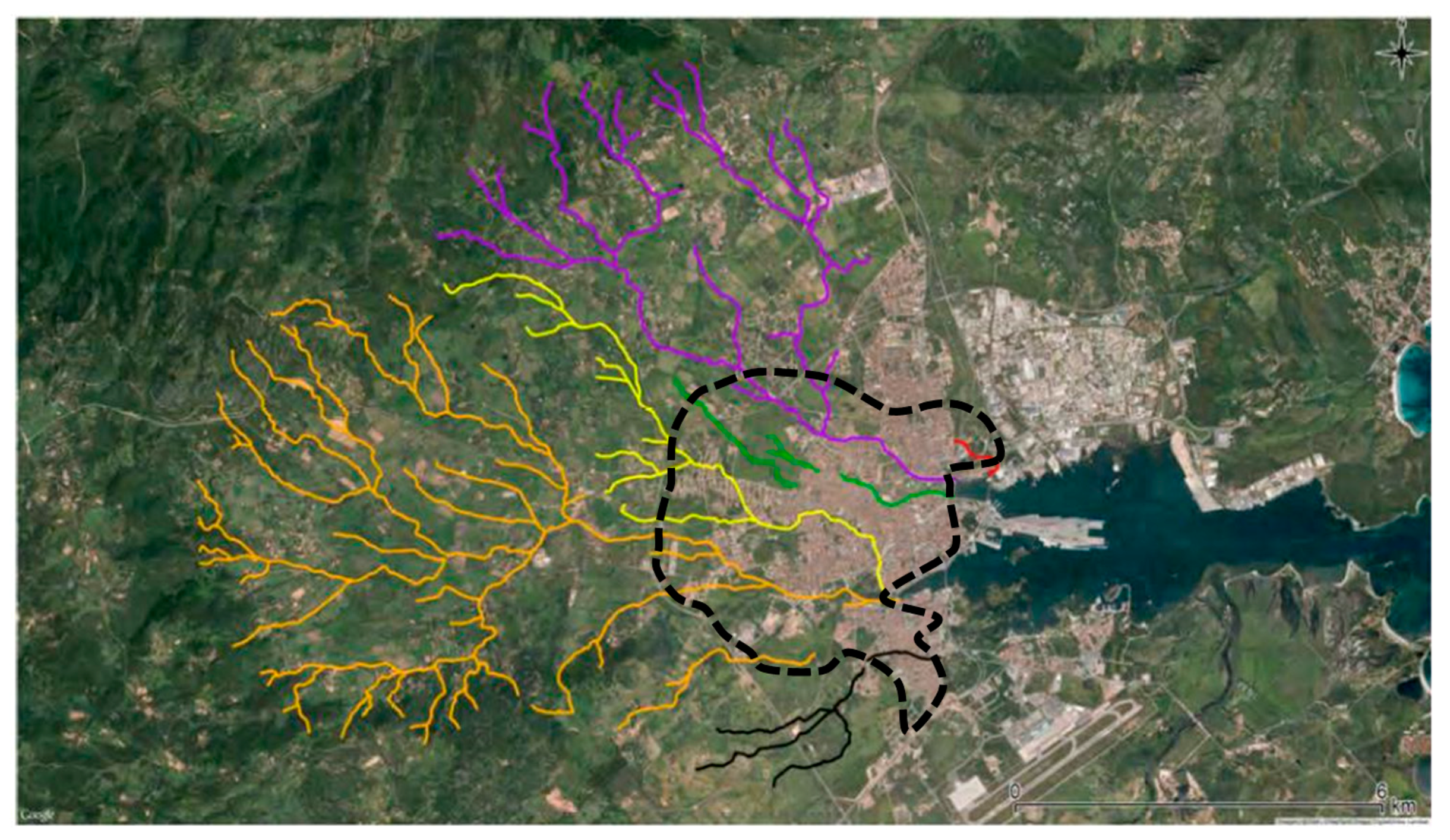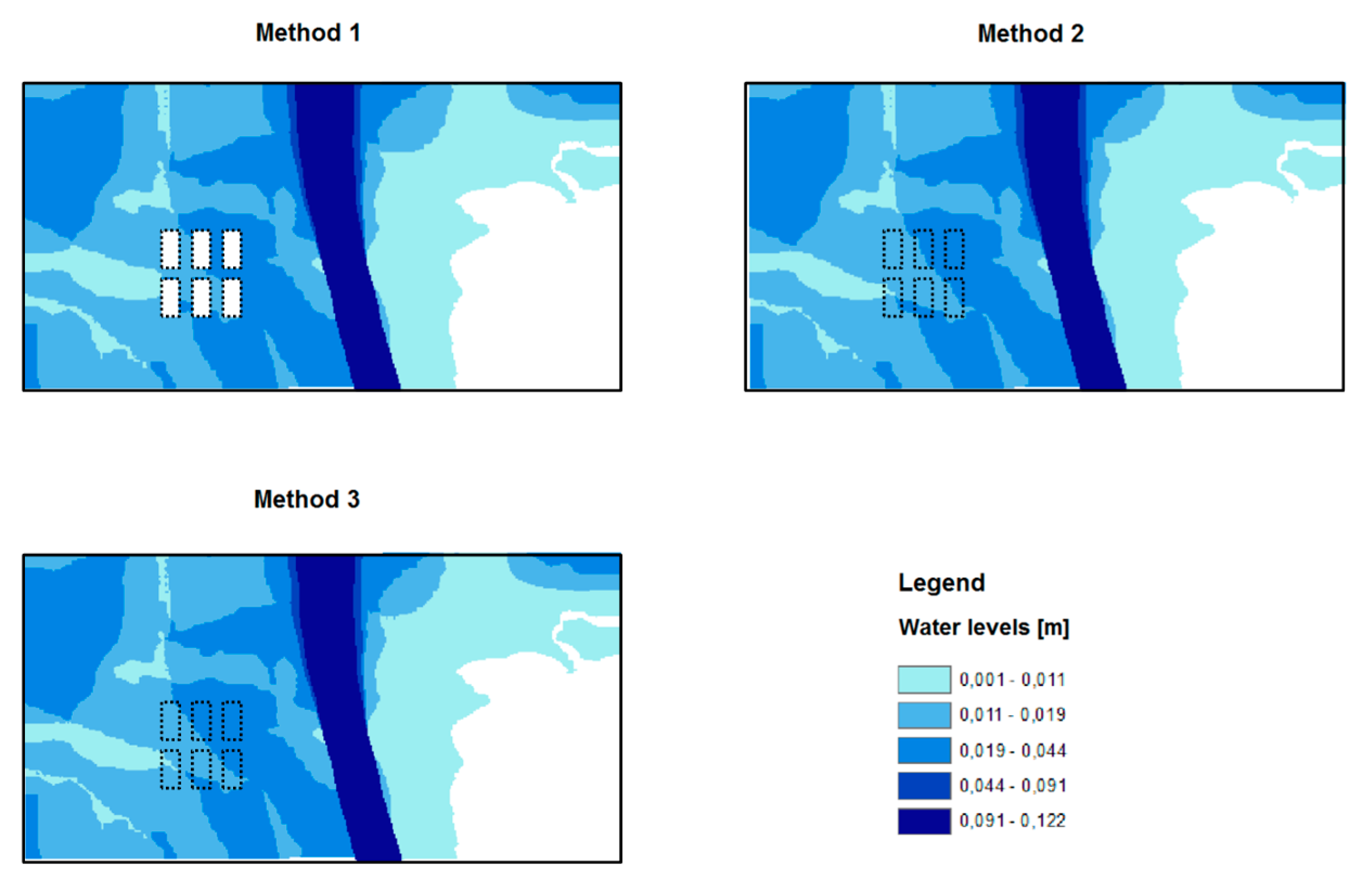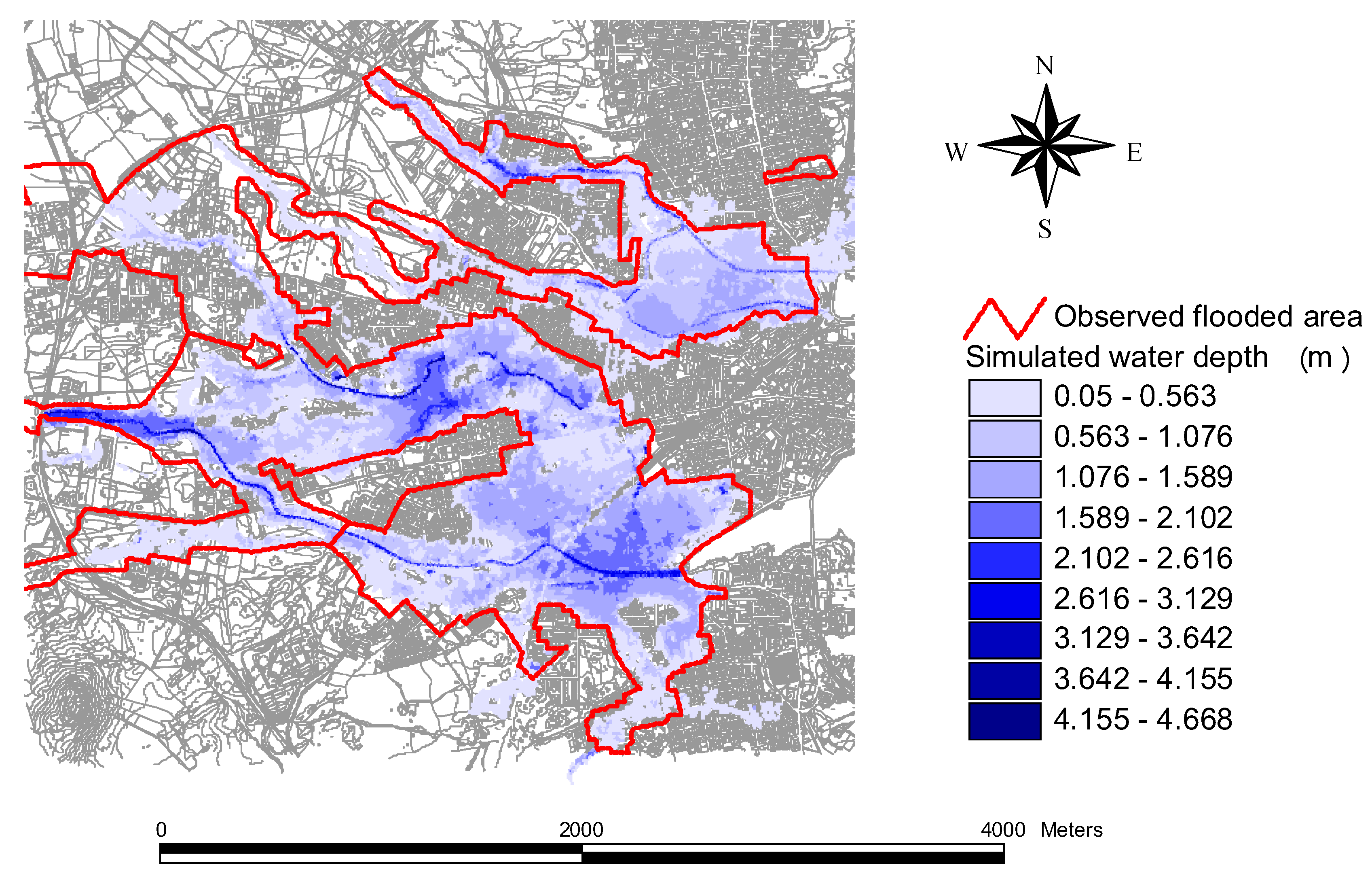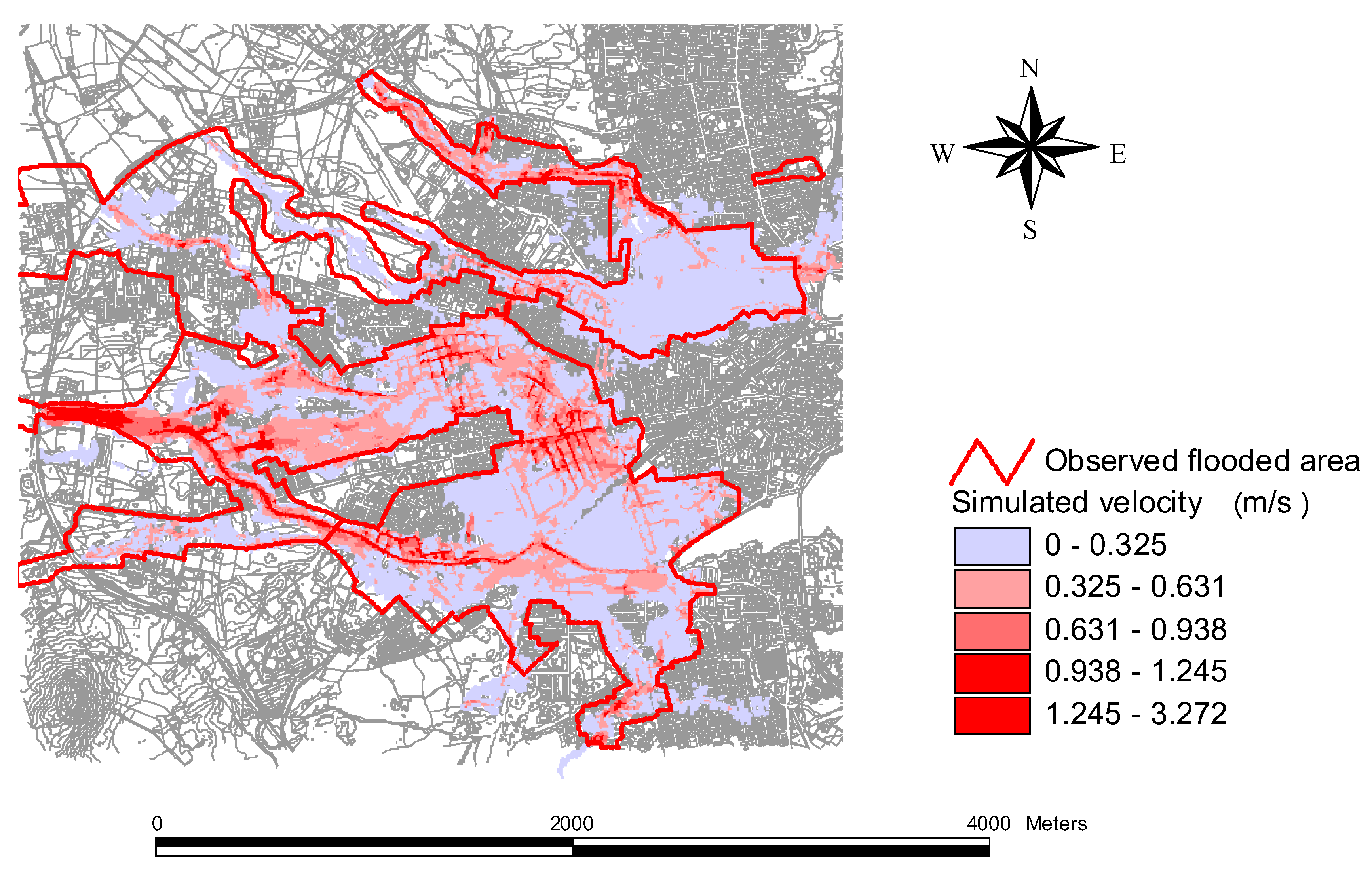Simulating the Influence of Buildings on Flood Inundation in Urban Areas
Abstract
1. Introduction
2. Materials and Methods
2.1. Experimental Setup
2.2. Mathematical Hydraulic Modelling
- Method 1: incorporation of buildings using the detailed digital elevation model (DEM) with 1 cm spatial resolution.
- Method 2: buildings are replaced by a flat area with high roughness (Manning coefficient = 10).
- Method 3: all urban area is replaced by a flat area with high roughness (Manning coefficient = 0.15).
2.3. Hydrologic Model
2.4. The 2013 Flood in Olbia
3. Results
3.1. Simulation of Flow Depth and Velocity of the Laboratory Experiments
3.2. Simulation of Olbia Flood Inundation
4. Conclusions
Acknowledgments
Author Contributions
Conflicts of Interest
References
- Berz, G.; Kron, W.; Loster, T.; Rauch, E.; Schimetschek, J.; Schmieder, J.; Siebert, A.; Smolka, A.; Wirtz, A. World map of natural hazards—A global view of the distribution and intensity of significant exposures. Nat. Hazards 2001, 23, 443–465. [Google Scholar] [CrossRef]
- Milly, P.C.D.; Wetherald, R.T.; Dunne, K.A.; Delworth, T.L. Increasing risk of great floods in a changing climate. Nature 2002, 415, 514–517. [Google Scholar] [CrossRef] [PubMed]
- De Almeida, G.A.M.; Bates, P.; Freer, J.; Souvignet, M. Improving the stability of a simple formulation of the shallow water equations for 2-D flood modeling. Water Resour. Res. 2012, 48, W05528. [Google Scholar] [CrossRef]
- Peraire, J.; Zienkiewicz, O.C.; Morgan, K. Shallow water problems: a general explicit formulation. Int. J. Numer. Methods Eng. 1986, 22, 547–574. [Google Scholar] [CrossRef]
- Toro, E.F.; Garcia-Navarro, P. Godunov-type methods for freesurface shallow flows: A review. J. Hydraul. Res. 2007, 45, 736–751. [Google Scholar] [CrossRef]
- Guinot, V.; Frazão, S. Flux and source term discretization in two-dimensional shallow water models with porosity on unstructured grids. Int. J. Numer. Method Fluids 2006, 50, 309–345. [Google Scholar] [CrossRef]
- LeVeque, R.J.; George, D.L. High-resolution finite volume methods for the shallow water equations with bathymetry and dry states. In Advanced Numerical Models for Simulating Tsunami Waves and Runup; World Scientific: Singapore, 2008; Available online: http://www.amath.washington.edu/rjl/pubs/catalina04 (accessed on 10 January 2018).
- Sanders, B.; Schubert, J.E.; Gallegos, H.A. Integral formulation of shallow-water equations with anisotropic porosity for urban flood modeling. J. Hydrol. 2008, 362, 19–38. [Google Scholar] [CrossRef]
- Li, S.; Duffy, C.J. Fully coupled approach to modeling shallow water flow, sediment transport, and bed evolution in rivers. Water Resour. Res. 2011, 47, W03508. [Google Scholar] [CrossRef]
- Tsakiris, G. Flood risk assessment: Concepts, modelling, applications. Nat. Hazard Earth Syst. Sci. 2014, 14, 1361–1369. [Google Scholar] [CrossRef]
- Alcrudo, F. Mathematical Modelling Techniques for Flood Propagation in Urban Areas. IMPACT Project Technical Report. Available online: http://www.impact-project.net/AnnexII_DetailedTechnicalReports/AnnexII_PartB_WP3/Modelling_techniques_for_urban_flooding.pdf (accessed on 10 January 2018).
- Liu, L.; Liu, Y.; Wang, X.; Yu, D.; Liu, K.; Huang, H.; Hu, G. Developing an effective 2-D urban flood inundation model for city emergency management based on cellular automata. Nat. Hazards Earth Syst. Sci. 2015, 15, 381–391. [Google Scholar] [CrossRef]
- Dottori, F.; Todini, E. Testing a simple 2D hydraulic model in an urban flood experiment. Hydrol. Proces. 2013, 27, 1301–1320. [Google Scholar] [CrossRef]
- McMillan, H.K.; Brasington, J. Reduced complexity strategies for modelling urban floodplain inundation. Geomorphology 2007, 90, 226–243. [Google Scholar] [CrossRef]
- Hunter, N.M.; Bates, P.D.; Horritt, M.S.; Wilson, M.D. Simple spatially distributed models for predicting flood inundation: A review. Geomorphology 2007, 90, 208–225. [Google Scholar] [CrossRef]
- Prestininzi, P. Suitability of the diffusive model for dam break simulation: Application to a CADAM experiment. J. Hydrol. 2008, 361, 172–185. [Google Scholar] [CrossRef]
- Lopes, P.; Leandro, J.; Carvalho, R.F.; Páscoa, P.; Martins, R. Numerical and experimental investigation of a gully under surcharge conditions. Urban Water J. 2015, 12, 468–476. [Google Scholar] [CrossRef]
- Bazin, P.-H.; Nakagawa, H.; Kawaike, K.; Paquier, A.; Mignot, E. Modeling flow exchanges between a street and an underground drainage pipe during urban floods. J. Hydraul. Eng. 2014, 140, 4014051. [Google Scholar] [CrossRef]
- Zhou, Q.; Yu, W.; Chen, A.S.; Jiang, C.; Fu, G. Experimental assessment of building blockage effects in a simplified urban district. Procedia Eng. 2016, 154, 844–852. [Google Scholar] [CrossRef]
- Testa, G.; Zuccala, D.; Alcrudo, F.; Mulet, J.; Soares-Frazão, S. Flash flood flow experiment in a simplified urban district. J. Hydraul. Res. 2007, 45, 37–44. [Google Scholar] [CrossRef]
- US Army Corps of Engineers—Hydrologic Engineering Center. Hydraulic Reference Manual. Available online: http://www.hec.usace.army.mil/software/hec-ras/documentation/HEC-RAS%205.0%20Reference%20Manual.pdf (accessed on 10 January 2018).
- Kim, J.; Ivanov, V.Y.; Katopodes, N.D. Hydraulic resistance to overland flow on surfaces with partially submerged vegetation. Water Resour. Res. 2012, 48, W10540. [Google Scholar]
- Sammarco, P.; Di Risio, M. Effects of moored boats on the gradually varied free-surface profiles of river flows. J. Waterw. Port Coast. Ocean Eng. 2016, 143, 04016020. [Google Scholar] [CrossRef]
- Yamashita, K.; Suppasri, A.; Oishi, Y.; Imamura, F. Development of a tsunami inundation analysis model for urban areas using a porous body model. Geosciences 2018, 8, 12. [Google Scholar] [CrossRef]
- US Army Corps of Engineers—Hydrologic Engineering Center. HEC-RAS 5.0 River Analysis System 2D Modeling User’s Manual. Available online: http://www.hec.usace.army.mil/software/hec-ras/documentation/HEC-RAS%205.0%202D%20Modeling%20Users%20Manual.pdf (accessed on 10 January 2018).
- Ravazzani, G.; Amengual, A.; Ceppi, A.; Homar, V.; Romero, R.; Lombardi, G.; Mancini, M. Potentialities of ensemble strategies for flood forecasting over the Milano urban area. J. Hydrol. 2016, 539, 237–253. [Google Scholar] [CrossRef]
- Ravazzani, G.; Bocchiola, D.; Groppelli, B.; Soncini, A.; Rulli, M.C.; Colombo, F.; Mancini, M.; Rosso, R. Continuous stream flow simulation for index flood estimation in an Alpine basin of Northern Italy. Hydrol. Sci. J. 2015, 60, 1013–1025. [Google Scholar] [CrossRef]
- Ravazzani, G.; Gianoli, P.; Meucci, S.; Mancini, M. Assessing downstream impacts of detention basins in urbanized river basins using a distributed hydrological model. Water Resour. Manag. 2014, 28, 1033–1044. [Google Scholar] [CrossRef]
- Ravazzani, G.; Gianoli, P.; Meucci, S.; Mancini, M. Indirect estimation of design flood in urbanized river basins using a distributed hydrological model. J. Hydrol. Eng. 2014, 19, 235–242. [Google Scholar] [CrossRef]
- Ehlschlaeger, C.R. Using the AT search algorithm to develop hydrologic models from digital elevation data. In Proceedings of the International Geographic Information System (IGIS) Symposium, Baltimore, MD, USA, 18–19 March 1989. [Google Scholar]
- Soil Conservation Service. National Engineering Handbook, Hydrology, Section 4; US Department of Agriculture: Washington, DC, USA, 1986.
- Miliani, F.; Ravazzani, G.; Mancini, M. Adaptation of precipitation index for the estimation of Antecedent Moisture Condition (AMC) in large mountainous basins. J. Hydrol. Eng. 2011, 16, 218–227. [Google Scholar] [CrossRef]
- Ponce, V.M.; Chaganti, P.V. Variable—Parameter Muskingum—Cunge method revisited. J. Hydrol. 1994, 162, 433–439. [Google Scholar] [CrossRef]








| Point | Observed Water Level (m) | Simulated Water Level (m) | ||
|---|---|---|---|---|
| Method 1 | Method 2 | Method 3 | ||
| A | 0.014 | 0.009 | 0.009 | 0.009 |
| B | 0.022 | 0.014 | 0.013 | 0.014 |
| C | 0.022 | 0.016 | 0.016 | 0.016 |
| D | 0.044 | 0.024 | 0.023 | 0.024 |
| E | 0.015 | 0.019 | 0.019 | 0.019 |
| F | 0.021 | 0.021 | 0.021 | 0.022 |
| G | 0.016 | 0.018 | 0.019 | 0.019 |
| H | 0.024 | 0.022 | 0.021 | 0.022 |
| I | 0.011 | 0.008 | 0.009 | 0.009 |
| J | 0.010 | 0.014 | 0.014 | 0.014 |
| K | 0.017 | 0.018 | 0.018 | 0.018 |
| L | 0.040 | 0.023 | 0.022 | 0.022 |
| M | 0.019 | 0.019 | 0.019 | 0.019 |
| N | 0.044 | 0.027 | 0.026 | 0.026 |
| Point | Observed Water Velocity (m/s) | Simulated Water Velocity (m/s) | ||
|---|---|---|---|---|
| Method 1 | Method 2 | Method 3 | ||
| A | 0.505 | 0.345 | 0.331 | 0.351 |
| B | 0.416 | 0.392 | 0.370 | 0.369 |
| C | 0.862 | 0.340 | 0.355 | 0.341 |
| D | 0.590 | 0.373 | 0.368 | 0.349 |
| E | 0.359 | 0.400 | 0.350 | 0.072 |
| F | 0.497 | 0.400 | 0.330 | 0.058 |
| G | 0.267 | 0.103 | 0.442 | 0.078 |
| H | 0.267 | 0.117 | 0.450 | 0.072 |
| I | NA | 0.412 | 0.459 | 0.440 |
| J | 0.382 | 0.490 | 0.530 | 0.086 |
| K | 0.566 | 0.550 | 0.550 | 0.092 |
| L | 0.673 | 0.526 | 0.515 | 0.546 |
| M | 0.244 | 0.390 | 0.416 | 0.432 |
| N | 0.659 | 0.700 | 0.680 | 0.687 |
| Method 1 | Method 2 | Method 3 | |
|---|---|---|---|
| Level | 0.248 (0.157) | 0.257 (0.161) | 0.252 (0.154) |
| Velocity | 0.309 (0.214) | 0.347 (0.244) | 0.551 (0.288) |
| Water Levels | Water Velocities | |||
|---|---|---|---|---|
| Simulation | Diffusive | Dynamic | Diffusive | Dynamic |
| H1 | 0.04 | 0.11 | 0.64 | 0.27 |
| H10 | 0.04 | 0.09 | 0.71 | 0.22 |
© 2018 by the authors. Licensee MDPI, Basel, Switzerland. This article is an open access article distributed under the terms and conditions of the Creative Commons Attribution (CC BY) license (http://creativecommons.org/licenses/by/4.0/).
Share and Cite
Beretta, R.; Ravazzani, G.; Maiorano, C.; Mancini, M. Simulating the Influence of Buildings on Flood Inundation in Urban Areas. Geosciences 2018, 8, 77. https://doi.org/10.3390/geosciences8020077
Beretta R, Ravazzani G, Maiorano C, Mancini M. Simulating the Influence of Buildings on Flood Inundation in Urban Areas. Geosciences. 2018; 8(2):77. https://doi.org/10.3390/geosciences8020077
Chicago/Turabian StyleBeretta, Riccardo, Giovanni Ravazzani, Carlo Maiorano, and Marco Mancini. 2018. "Simulating the Influence of Buildings on Flood Inundation in Urban Areas" Geosciences 8, no. 2: 77. https://doi.org/10.3390/geosciences8020077
APA StyleBeretta, R., Ravazzani, G., Maiorano, C., & Mancini, M. (2018). Simulating the Influence of Buildings on Flood Inundation in Urban Areas. Geosciences, 8(2), 77. https://doi.org/10.3390/geosciences8020077






